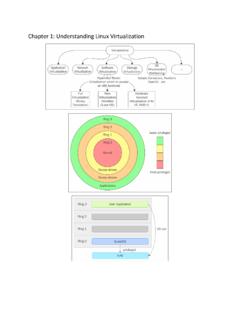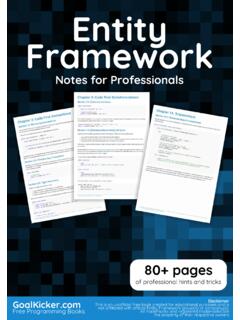Transcription of Entity Framework Tutorial - Packt Publishing
1 Entity Framework Tutorial Joydip Kanjilal Chapter No. 2 " getting started " For More Information: In this package, you will find: A Biography of the author of the book A preview chapter from the book, Chapter " getting started " A synopsis of the book s content Information on where to buy this book About the Author Joydip Kanjilal is a Microsoft MVP in He has over 12 years of industry experience in IT with more than 6 years in Microsoft .NET and its related technologies. He has authored many articles for some of the most reputable sites like, , , , , , , etc. Several of these articles have been featured at Microsoft's Official Site on Joydip was also a community credit winner at a number of times. He is currently working as a Senior Consultant in a reputable company in Hyderabad, INDIA. He has years of experience in designing and architecting solutions for various domains. His technical strengths include C, C++, VC++, Java, C#, Microsoft.
2 NET, Ajax, Design Patterns, SQL Server, Operating Systems, and Computer Architecture. Joydip blogs at and spends most of his time reading books, blogs, and writing books and articles. His hobbies include watching cricket and soccer and playing chess. For More Information: Writing a book is always a rewarding experience. My special thanks to Douglas Paterson for providing me the opportunity to author this book turning this idea into a reality. I am also thankful to the entire Packt team for their support. I am also thankful to Abhishek Kant (Microsoft), Steve Smith (AspAlliance), Russell Jones(DevX), Steve Jones(SSWUG), Jude Kelly (SQL Server Performance), and Anand Narayaswamy (AspAlliance) for their inspiration and support. My heartiest thanks to my friends Tilak and Vinod for their continued encouragement. My deepest respects and gratitude to my parents for their love, blessings, and encouragement. My thanks to my other family members too, for their support, and to little Jini in particular, for her continued inspiration and love.
3 Thank you all so much! For More Information: Entity Framework Tutorial The Entity Framework , the next generation of Microsoft's data access technology, is an extended Object Relational Mapping (ORM) technology that makes it easy to tie together the data in your database with the objects in your applications. This is done by abstracting the object model of an application from its relational or logical model. It is an extended ORM in the sense that it provides many additional features over an ORM. Some of these features are: Entity Inheritance and Composition Identity Resolution and Change Tracking LINQ Support The Object Service Layer This book is a clear and concise guide to the Entity Framework . Packed with plentiful code examples, this book helps you to learn the Entity Framework and Data Services and build a better data access layer for your application. What This Book Covers Chapter 1 is an introduction to the basics of the Entity Framework (EF), its usefulness, its features, and the benefits.
4 Chapter 2 discusses how you can get started with EF, create an Entity Data Model (EDM), and write a program to query data. Chapter 3 gives a detailed explanation of entities, relationships, and each of the sections of the EDM. Chapter 4 provides a sample application that illustrates how to perform CRUD operations against the EDM. Chapter 5 discusses the Entity SQL query language and how to work with the Entity Client provider. Chapter 6 includes a detailed discussion on LINQ to Entities with many code examples. Chapter 7 provides a detailed discussion on the Object Services Layer and its helpful and useful features. Chapter 8 provides an introduction to Data Services and how it can be used with the EDM to perform CRUD operations. For More Information: getting StartedIn the previous chapter we took a look at the Entity Framework including its architecture and its features. We also designed our Payroll database that we will be using throughout this book to store and retrieve data.
5 We will use the same database in this chapter to generate an Entity Data Model and then use it, along with the Entity Data Source control, to bind data to a GridView data this chapter, we will cover the following points:Creating an Entity Data ModelIntroducing the Entity Data Source ControlImplementing our fi rst application using the Entity FrameworkWe will start this chapter with a discussion on how we can create an Entity Data Model from our Payroll an Entity Data Model You can create the Entity Data Model in one of two ways:Use the Entity Data Model DesignerUse the command line Entity Data Model Designer called will fi rst take a look at how we can design an Entity Data Model using the Entity Data Model Designer which is a Visual Studio wizard that is enabled after you install Entity Framework and its tools. It provides a graphical interface that you can use to generate an Entity Data Model. For More Information: getting started [ 38 ]Creating the Payroll Entity Data Model Using the Entity Data Model DesignerHere again are the tables of our Payroll database that we will use to generate the data model:EmployeeDesignationDepartmentSalar yProvidentFund To create an Entity data model using the Entity Data Model Designer, follow these simple steps:1.
6 Open Visual and create a solution for a new web application project as seen below and save with a name. For More Information: Chapter 2[ 39 ]2. Switch to the Solution Explorer, right click and click on Add New Item as seen in the following screenshot: For More Information: getting started [ 40 ]3. Ne xt, select Entity Data Model from the list of the templates displayed as shown in the following screenshot:4. Nam e the Entity Data Model PayrollModel and click on Select Generate from database from the Entity Data Model Wizard as shown in the following screenshot: For More Information: Chapter 2[ 41 ]Note that you can also use the Empty model template to create the Entity Data Model yourself. If you select the Empty Data Model template and click on next, the following screen appears:As you can see from the above fi gure, you can use this template to create the Entity Data Model yourself. You can create the Entity Types and their rela-tionships manually by dragging items from the toolbox.
7 We will not use this template in our discussion here. So, let's get to the next C lick on Next in the Entity Data Model Wizard window shown earlier. For More Information: getting started [ 42 ]7. The modal dialog box will now appear and prompts you to choose your connection as shown in the following fi gure:8. Click on New Connection Now you will need to specify the connection properties and parameters as shown in the following fi gure: For More Information: Chapter 2[ 43 ]We will use a dot to specify the database server name. This implies that we will be using the database server of the localhost, which is the current system in After you specify the necessary user name, password, and the server name, you can test your connection using the Test Connection button. When you do so, the message Test connection succeeded gets displayed in the message box as shown in the previous fi gure. For More Information: getting started [ 44 ]10.
8 When you click on OK on the Test connection dialog box, the following screen appears:Note the Entity Connection String generated automatically. This connection string will be saved in the ConnectionStrings section of your application's fi le. This is how it will look like: <connectionStrings> <add name="PayrollEntities" connectionString="metadata=res:// *;provider= ;provider connection string="Data Source=.;Initial Catalog=Payroll;User ID=sa;Password=joydip1@3;MultipleActiveResultSets=True"" providerName=" " /> </connectionStrings> For More Information: Chapter 2[ 45 ]11. When you click on Next in the previous fi gure, the following screen appears: For More Information: [ 46 ]12. E xpand the Tables node and specify the database objects that you require in the Entity Data Model to be generated as shown in the following fi gure:13. Cl ick on Finish to generate the Entity Data is the output displayed in the Output Window while the Entity Data Model is being generated: getting started For More Information: Chapter 2[ 47 ]Your Entity Data Model has been generated and saved in a fi le named We are done creating our fi rst Entity Data Model using the Entity Data Model Designer you op en the Payroll Entity Data Model that we just created in the designer view, it will appear as shown in the following fi gure:Note how the Entity Types in the above model are related to one another.
9 These relationships have been generated automatically by the Entity Data Model Designer based on the relationships between the tables of the Payroll database we created in the previous the next section, we will learn how we can create an Entity Data Model using the command line the Payroll Data Model Using the EdmGen ToolWe will now take a look at how to create a data model using the Entity Data Model generation tool called EdmGen. For More Information: getting started [ 48 ]The command line tool can be used to do one or more of the following:Generate the .cdsl, .msl, and .ssdl fi les as part of the Entity Data ModelGenerate object classes from a .csdl fi leValidate an Entity Data ModelThe command line tool generates the Entity Data Model as a set of three fi les: .csdl, .msl, and .ssdl. If you have used the Entity Data Model Designer to generate your Entity Data Model, the .edmx fi le generated will contain the CSDL, MSL, and the SSDL sections.
10 You will have a single .edmx fi le that bundles all of these sections into it. On the other hand, if you use the tool to generate the Entity Data Model, you would fi nd three distinctly separate fi les with .csdl, .msl or .ssdl is a list of the major options of the command line tool:OptionDescription/helpUse this option to display help on all the possible options of this tool. The short form is /?/language:CSharpUse this option to generate code using C# language/language:VBUse this option to generate code using VB language/provider:<string>Use this option to specify the name of the data provider that you would like to :<connection string>Use this option to specify the connection string to be used to connect to the database/namespace:<string>Use this option to specify the name of the namespace/mode:FullGenerationUse this option to generate your CSDL, MSL, and SSDL objects from the database schema/mode:EntityClassGenerationUse this option to generate your Entity classes from a given CSDL fi le/mode:FromSsdlGenerationUse this option to generate MSL, CSDL, and Entity Classes from a given SSDL fi le/mode:ValidateArtifactsUse this option to validate the CSDL, SSDL, and MSL fi les/mode:ViewGenerationUse this option to generate mapping views from the CSDL, SSDL, and MSL fi les For More Information.














